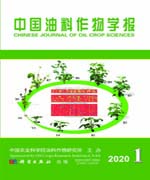SUN Zhi-jun, CAI Ying-bo, LYU Hao, WANG Jie-qi, LIU Han-xi, WEN Ying-nan, LIU Chun-yan, WANG Jin-hui, XIN Da-wei , CHEN Qing-shan (
Nitrogen is an important nutrient for plant growth, and biological nitrogen fixation is an important
source of nitrogen to soybean growth. In this study, we used Suinong14 as the recurrent parent and wild bean
ZYD00006 as the male parent to construct an introgression lines covering the whole genome of wild soybean. QTL
mapping of nodule number and nodule dry weight based on soybean introduced line group. Three QTLs for nodule
dry weight, located on three linkage groups of N, M and D2. Five QTLs for nodule number, located on linkage
groups K, F, J and D2. There are overlapping segments (7.20-7.79Mb) on D2 linkage group. Gene annotation was
performed on 63 genes in this overlapping segment, and 6 genes related to symbiosis and disease resistance were se‐
lected as candidate genes for further verification. The qRT-PCR analysis showed that the expression pattern of Gly⁃
ma.17G097000 during rhizobial infection was very different compared to the control. Glyma.17G097000 belongs to
the GmHIR gene family, and 11 family members were found in the soybean genome. The structural similarity of Gm⁃
HIR family genes is very high, and genes expression is tissue-specific. Soybean HIR protein has two domains,
Stomatins and Prohibitin, and can participate in physiological processes such as ion channel regulation, which are
related to plant disease resistance and cell cycle. The GmHIR genes are derived from four ancestors and highly con‐
served during evolution. The qRT-PCR analysis of 11 members of GmHIR gene family showed that the expression patterns of these three genes Glyma.05G029800, Glyma.09G154400 and Glyma.17G097000 during rhizobial infec‐
tion were significantly different from the control. These results indicated that these three genes could have played an
important role in the establishment of a soybean symbiosis system, and participated in the regulation of ion channels
and immune responses during the establishment of a symbiotic system of rhizobium and soybean. This study lays the
foundation for the study of soybean-rhizobia symbiosis mechanism and provides effective candidate genes.
